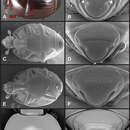Description
provided by Zookeys
Length: 1.90–2.25 mm, width: 1.68–1.97 mm; body rufopiceous, broadly rounded; frons shallowly depressed at middle, with fine, sparse ground punctation; sides of frontal stria divergent, rounded, sinuate over antennal bases, arcuate across front; supraorbital stria fine, rounded dorsad, detached from sides of frontal stria; epistoma moderately convex; labrum about twice as wide as long, asymmetrically emarginate apically, projecting beneath; left mandible untoothed, right mandible with small, subacute basal tooth; pronotum lacking prescutellar impression, with fine, sparse ground punctation, lacking lateral pronotal punctures; anterior margin of pronotum very weakly projecting at middle; marginal pronotal stria generally broadly interrupted behind head; submarginal pronotal stria continuous, complete along lateral and anterior margins, marginal bead convex; median pronotal gland openings about three-fourths pronotal length behind anterior margin; elytra with single complete epipleural striae, outer subhumeral stria complete, sinuate at middle, inner subhumeral stria absent, subhumeral region strongly, narrowly convex, dorsal striae 1-3 complete, 4th and 5th striae similar in length, present in about apical third, sutural present in apical two-thirds; prosternal keel broad, very weakly projecting at base, carinal striae complete, broadly separated at base, meeting in broad anterior arch; anterior metaventral margin broadly, very shallowly emarginate, marginal stria complete or narrowly interrupted; mesometaventral stria broadly arched forward at middle to near marginal mesoventral stria, continued obliquely posterolaterad, abbreviated apically; 1st abdominal ventrite with two lateral striae, inner usually complete, curved mediad posteriorly, outer stria abbreviated, a small fovea present near inner corner of metacoxa; propygidium with fine, moderately sparse ground punctation and irregularly oval, shallow punctures over most of disk except posterolateral corners, separated by one-fourth their diameters or slightly more; pygidium with fine, dense ground punctation, lacking coarser punctures except for few small punctures along basal margin; marginal pygidial sulcus deep, but rather narrow along most of margin, ending in large, more or less round basal foveae. Male genitalia (Figs 66A–C, H): accessory sclerites absent; T8 with sides weakly convergent to subtruncate apex, apical emargination narrow, deep, basal emargination narrowly rounded, nearly reaching basal membrane attachment line, ventrolateral apodemes most strongly developed basally, narrowed to apex; S8 with sides weakly convergent to apex, apical guides narrow, widening only slightly to apex, halves weakly fused along most of ventral midline; T9 with sides subparallel in basal half, convergent to broad, subtruncate, weakly convergent apices; halves of T10 almost completely fused, with only very narrow apical emargination between; S9 rather short, narrowed at middle, widening slightly to subtruncate base, apical emargination shallow, apical flanges separate; tegmen short, broad, widest just distad midpoint, narrowing weakly to base and more strongly to apex, with strong dorsoventral curvature, medioventral process projecting beneath, about one-third from tegmen base; median lobe prominent, about three-fourths tegmen length, proximal apodemes strongly differentiated proximad gonopore; basal piece short, about one-fourth tegmen length.
- license
- cc-by-3.0
- copyright
- Michael S. Caterino, Alexey K. Tishechkin
- bibliographic citation
- Caterino M, Tishechkin A (2013) A systematic revision of Operclipygus Marseul (Coleoptera, Histeridae, Exosternini) ZooKeys 271: 1–401
- author
- Michael S. Caterino
- author
- Alexey K. Tishechkin

